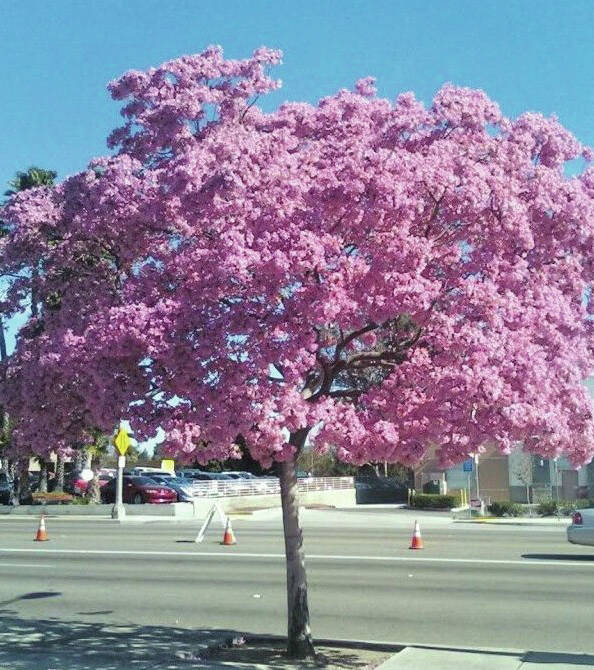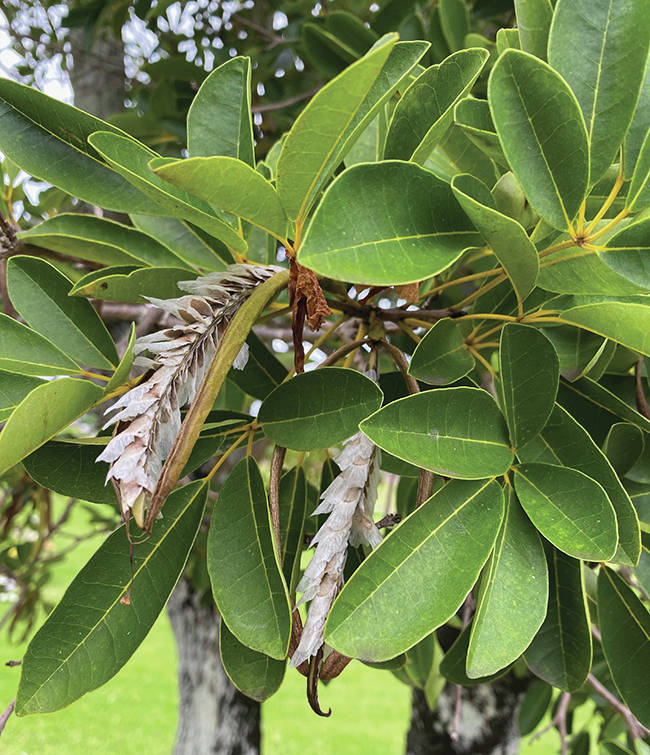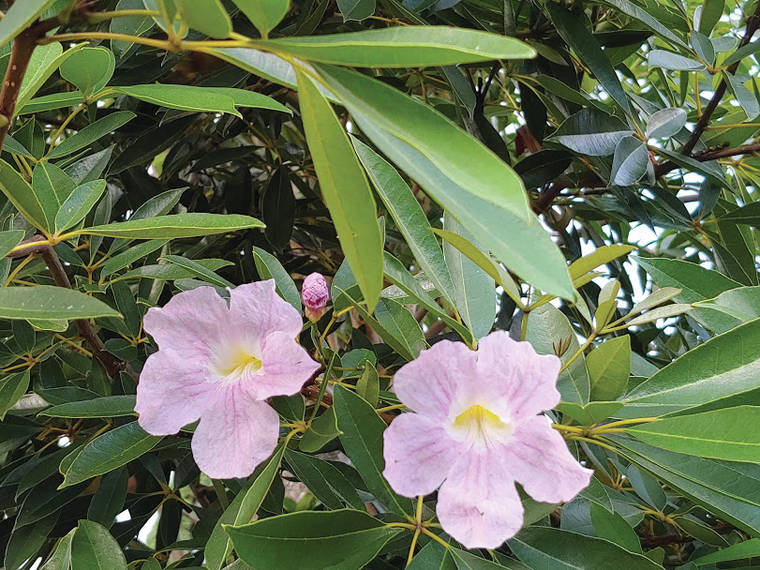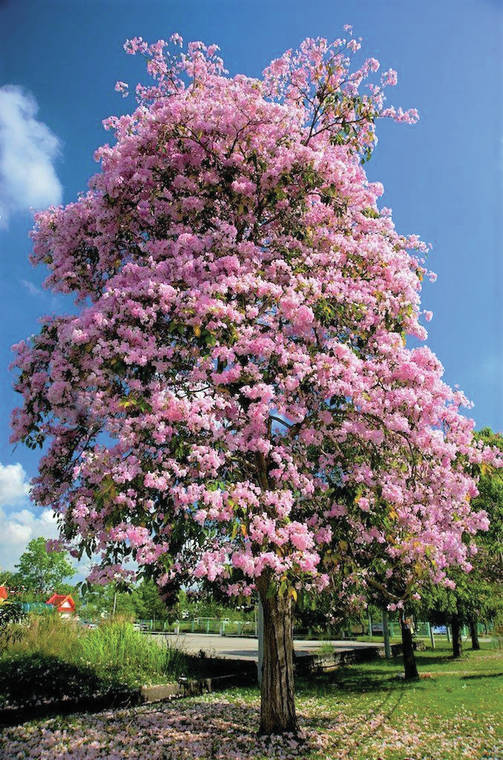Add delicate color with pink tecoma

Pink tecoma trees are often kept low when used as street trees. (amazon.com/via Diana Duff)

Part of the charm of the pink tecoma tree is the carpet of spent flowers it lays at its base. (Diana Duff/Special to West Hawaii Today)

When mature, the seed pods of the pink tecoma split open revealing seeds ready to sail on the wind. (selectree.calpoly.edu/via Diana Duff)

Pink tecoma flowers are usually pastel pink with yellow throats. (Diana Duff/Special to West Hawaii Today)

The natural growth habit of the gorgeous pink tecoma tree is tall and upright. (mapio.net/via Diana Duff)
Many years ago, I bought a beautiful pink tecoma tree at Kona Outdoor Circle’s Pua Plantasia plant sale. Though it had been pruned into a lovely horizontal shape about 5 feet tall, I later discovered that it was naturally a somewhat tall upright tree. The beautiful pink blossoms remain its most attractive feature today years after I let it return to its usual stately growth habit.
Many years ago, I bought a beautiful pink tecoma tree at Kona Outdoor Circle’s Pua Plantasia plant sale. Though it had been pruned into a lovely horizontal shape about 5 feet tall, I later discovered that it was naturally a somewhat tall upright tree. The beautiful pink blossoms remain its most attractive feature today years after I let it return to its usual stately growth habit.
Note to self: check on the natural growth habit of a tree before planting.
The pink tecoma is one of about a hundred species in the neo-tropical Tabebuia genus. More than a dozen flowering trees that grace Hawaiian landscapes are in this genus. They are often used as street trees as well as shade trees and make a lovely single specimen on a property. This genus along with more than a hundred others is in the Bignoniaceae family. Some local favorites that are also in this family include the orange trumpet vine, the unusual sausage tree and the gorgeous jacaranda tree.
Like the jacaranda, the fallen blossoms of the pink tecoma fall, freckling the ground below with its pastel-colored spent flowers. Their delicate color is almost as attractive on the lawn as it is clustered among the dark green leaves of the tree. Known botanically as Tabebuia heterophylla, some pink tecoma cultivars will produce flowers that are light lavender or nearly white. All have a tubular shape and most open with a light yellow throat.
Pink tecoma is native to the West Indies where its presence is widespread. The beauty of its pink flowers have made it popular as an ornamental tree today in many of the tropical locales.
Though it was somewhat rare in Hawaii as late as 1940, this Tabebuia has since spread throughout the state for use as a street tree as well as a landscape-enhancing specimen.
Several other members of the Tabebuia genus, produce flowers that are similar in size and shape but bloomin a variety of other colors. Probably pink tecoma’s most popular relative is the gold tree (Tabebuia donnnell-smithii) which puts out a stunning array of gold flowers for a few months every spring. Several other relatives produce yellow flowers while some produce flowers in white, lavender and even shades of magenta.
The tubular flowers of the pink tecoma are a little more than an inch across and grow in clusters among the leaves. At the height of their spring blooming season, the trees are a mass of pink blossoms. Most trees will continue to bloom less profusely off and on throughout the year. The seed pods that follow flowers contain lots viable seeds that can be used to propagate new plants. The seeds are equipped with a tuft of fibers that allow them to be easily spread by wind. Removing the pods before they open can prevent wide dispersal of the seeds.
To propagate from seeds, collect the seeds when the pods open and place them in a moist seeding mix. They will usually sprout in a few weeks and produce new leaves quickly. Once they are three to six inches tall, they should be transferred to a larger pot or placed where their tap roots will have room to grow. When they are ready to out plant, consideration of the tree’s preferences will help in selecting a location.
It is the wide tolerance and adaptability of pink tecoma trees that help recommend them to gardeners as well as city planners. The trees are drought tolerant, making them ideal for xeriscape gardens. They grow well in hot, dry, sunny locations though they can adapt to cooler areas as well. The wood has shown durability in salt water indicating that the tree can probably adapt to landscapes close to the shore line and salt spray.
Though pink tecoma trees can grow somewhat quickly to 30 feet tall, regular pruning can control height and shape. Unless you plan to prune your tree to keep it low, it will require little care. Fertilizing with a balanced product three or four times a year can help the tree thrive. Healthy trees are not usually attacked by insects or diseases.
The appeal of pink tecoma and others in the Tabebuia genus and the Bignoniaceae family is often their beautiful flowers and their striking appearance in the landscape. As long as you are happy with a carpet of flowers following heavy blooms, you might want to consider enhancing your garden with one of these beauties.
Pink tecoma seeds are available online and trees are available locally. Call around to find them or call Margo at 640-9191 to find one for you.
Diana Duff is a plant adviser, educator and consultant living part time in Kailua-Kona.
Gardening Events
Every Saturday: “Work Day at Amy Greenwell Garden” from 9 a.m. to 12:30 p.m. Meet at the Garden Visitor Center across from the Manago Hotel in Captain Cook. Come with a mask and be prepared to practice social distancing. Volunteers can help with garden maintenance and are invited to bring a brown bag lunch. Water and snacks provided. Call Peter at 323-3318 for more information.
Wednesday, September 16: “Music & Speaker event” sponsored by Hawaii Farmer’s Union United. Featuring local and internationally renowned musical artist Makana and ulu expert and author Dr. Noa Lincoln. Go to HFUU Facebook page for more information.
Online Webinars Available: “Women Farmers Network topics” at https://oahurcd.org/portfolio/wfn-tools
Farmer Direct Markets – check websites for new hours and online markets
Wednesday: “Ho’oulu Farmers Market” at Sheraton Kona Resort & Spa at Keauhou Bay
Saturday: “Keauhou Farmers Market” 8 a.m. to noon at Keauhou Shopping Center and online at www.keauhoufarmersmarket.com/onlinemarket.
“Kamuela Farmer’s Market” 7:30 a.m. to noon at Pukalani Stables
“Waimea Town Market” 7:30 a.m. to noon at the Parker School in central Waimea
“Waimea Homestead Farmers Market” from 7:30 a.m. to noon at the Waimea middle and elementary school playground
Sunday: “Pure Kona Green Market” 9 a.m. – 2 p.m. at Amy Greenwell Garden in Captain Cook
“Hamakua Harvest” 9 a.m. to 2 p.m. at Highway 19 and Mamane Street in Honokaa
Plant Advice Lines
Call 322-4892 to see when they will be back in service.


